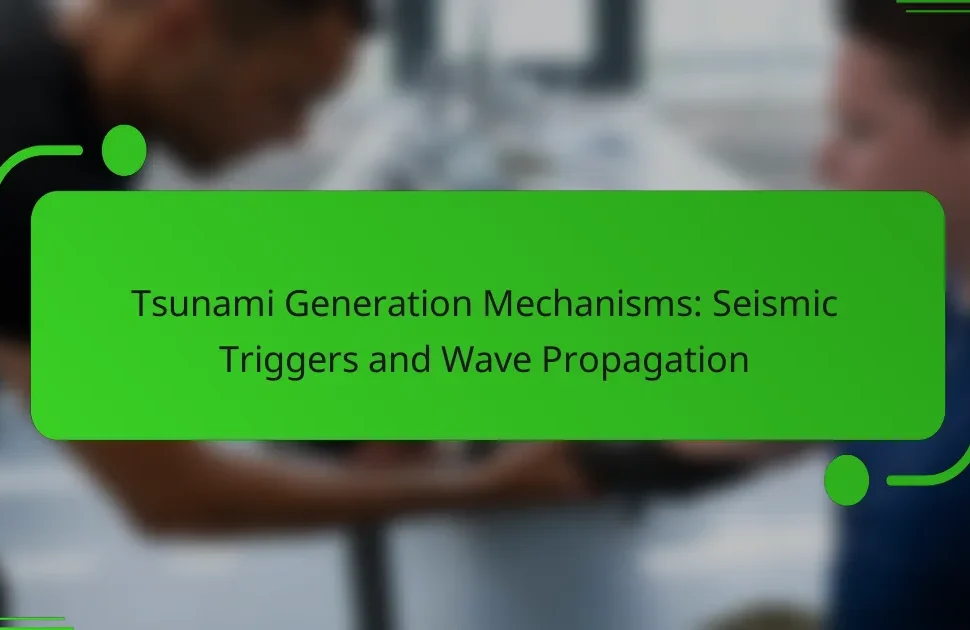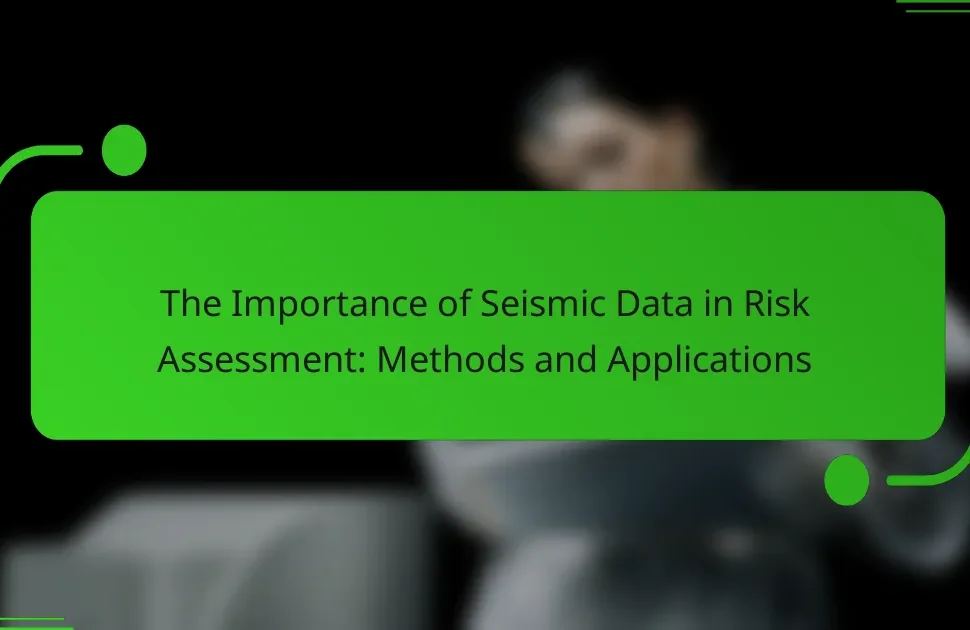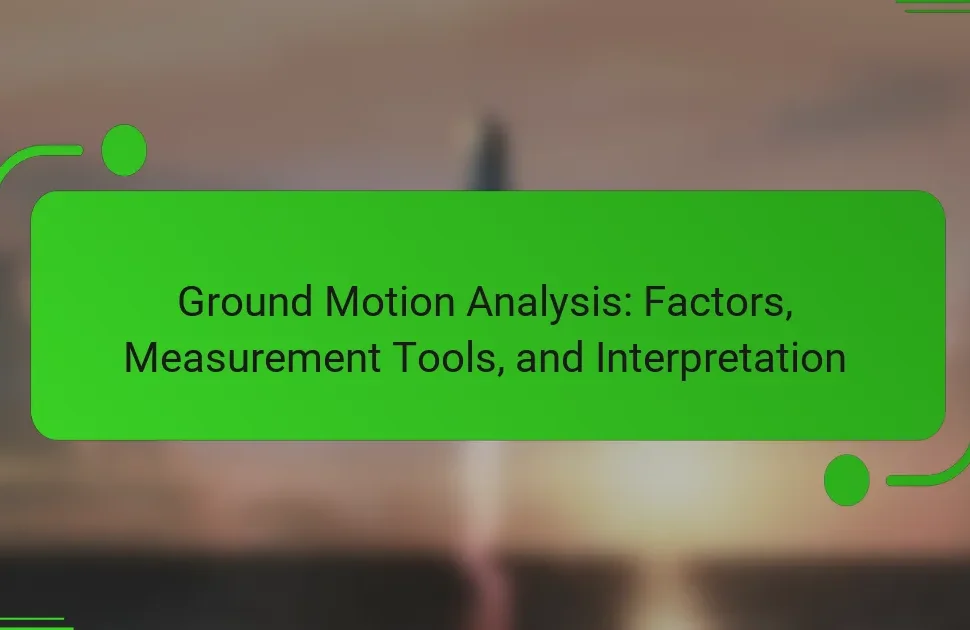Seismic waves are energy waves produced by the sudden release of energy in the Earth’s crust, primarily during earthquakes. They are categorized into body waves, which include primary waves (P-waves) and secondary waves (S-waves), and surface waves that travel along the Earth’s surface. The article explores the properties of seismic waves, such as speed, frequency, wavelength, and amplitude, which are essential for understanding their behavior. Measurement techniques using seismometers and seismographs are discussed, highlighting how these tools help analyze seismic events, determine their location, and assess earthquake risks. Understanding seismic waves is crucial for studying the Earth’s internal structure and designing structures that can withstand seismic activity.

What are Seismic Waves and Why are They Important?
Seismic waves are energy waves generated by the sudden release of energy in the Earth’s crust, typically during an earthquake. They travel through the Earth and are classified into two main types: body waves and surface waves. Body waves include primary waves (P-waves) and secondary waves (S-waves), while surface waves travel along the Earth’s surface. Seismic waves are important because they provide critical information about the Earth’s internal structure. They help scientists locate the epicenter of earthquakes and assess their magnitude. Additionally, studying seismic waves aids in understanding geological processes and predicting future seismic activity. Their analysis is essential for designing earthquake-resistant structures and mitigating disaster risks.
How are Seismic Waves Generated?
Seismic waves are generated by the sudden release of energy in the Earth’s crust. This release typically occurs during an earthquake, volcanic activity, or human-made explosions. The movement of tectonic plates creates stress along faults, leading to fractures. When the stress exceeds the strength of rocks, it results in a rupture. This rupture sends shockwaves through the Earth, creating seismic waves. There are two primary types of seismic waves: body waves and surface waves. Body waves travel through the Earth’s interior, while surface waves move along the Earth’s surface. The energy released can be measured using seismographs, which record the waves’ amplitude and frequency.
What natural phenomena produce Seismic Waves?
Seismic waves are produced by natural phenomena such as earthquakes, volcanic eruptions, and landslides. Earthquakes occur when tectonic plates shift, releasing energy in the Earth’s crust. This energy generates seismic waves that travel through the Earth. Volcanic eruptions can also create seismic waves due to the movement of magma and gases. Landslides result in the sudden displacement of earth material, generating seismic waves as well. These phenomena are significant sources of seismic activity, which can be measured and analyzed to understand Earth’s geological processes.
How do human activities contribute to Seismic Wave generation?
Human activities contribute to seismic wave generation primarily through construction, mining, and industrial processes. These activities create vibrations that propagate through the Earth. For example, heavy machinery used in construction can generate ground vibrations. Similarly, blasting in mining operations produces seismic waves. According to the U.S. Geological Survey, these anthropogenic activities can be detected by seismometers. The energy released during these processes can mimic natural earthquakes. This phenomenon is known as anthropogenic seismicity. It highlights the impact of human actions on seismic wave generation.
What are the Different Types of Seismic Waves?
The different types of seismic waves are primary waves (P-waves), secondary waves (S-waves), and surface waves. P-waves are compressional waves that travel fastest through solids, liquids, and gases. They cause particles to move back and forth in the same direction as the wave. S-waves are shear waves that only travel through solids. They move particles perpendicular to the wave direction, causing more destructive shaking. Surface waves travel along the Earth’s surface and typically cause the most damage during an earthquake. They have lower frequencies and can be divided into Love waves and Rayleigh waves. Love waves move side to side, while Rayleigh waves create an elliptical motion. These characteristics are crucial for understanding earthquake dynamics and their impact on structures.
What distinguishes Primary Waves from Secondary Waves?
Primary Waves (P-waves) differ from Secondary Waves (S-waves) in several key aspects. P-waves are longitudinal waves, meaning they compress and expand the material they travel through. S-waves, on the other hand, are transverse waves, which move the ground perpendicular to their direction of travel.
P-waves can travel through solids, liquids, and gases, while S-waves can only move through solids. This distinction is crucial during seismic events, as P-waves arrive first at seismic monitoring stations, followed by S-waves. The speed of P-waves is also faster than that of S-waves, typically traveling at about 5 to 8 kilometers per second in the Earth’s crust, compared to S-waves, which travel at 3 to 4.5 kilometers per second.
These differences are fundamental in understanding earthquake dynamics and in the interpretation of seismic data.
How do Surface Waves differ from Body Waves?
Surface waves travel along the Earth’s surface, while body waves travel through the Earth’s interior. Surface waves are typically slower than body waves. They cause more damage during earthquakes due to their larger amplitude and longer duration. Body waves are divided into primary (P) waves and secondary (S) waves. P waves are compressional and can travel through solids and liquids. S waves are shear waves and can only travel through solids. This distinction in travel paths and types leads to different behaviors during seismic events.

What are the Key Properties of Seismic Waves?
Seismic waves are energy waves that travel through the Earth, generated by geological phenomena. They possess key properties such as speed, frequency, wavelength, and amplitude. The speed of seismic waves varies depending on the medium they traverse. For example, primary waves (P-waves) travel faster than secondary waves (S-waves). Frequency refers to the number of wave cycles that pass a point per second. Higher frequency waves have shorter wavelengths. Wavelength is the distance between successive wave peaks. Amplitude measures the height of the wave, indicating the energy carried by the wave. These properties are crucial for understanding the behavior of seismic waves during events like earthquakes.
How do Seismic Waves Travel Through Different Materials?
Seismic waves travel through different materials by varying speeds and behaviors. P-waves, or primary waves, are compressional waves that move fastest through solids, liquids, and gases. They can travel through all types of materials due to their ability to compress and expand the medium. S-waves, or secondary waves, are shear waves that only move through solids. They are slower than P-waves and cannot travel through liquids or gases.
The speed of seismic waves is influenced by the density and elasticity of the material. For example, seismic waves travel faster in denser materials like granite compared to less dense materials like sediment. In geological studies, this principle is used to identify subsurface structures and compositions. Seismic wave travel times are measured to create models of the Earth’s interior. These models help in understanding tectonic movements and earthquake dynamics.
What role does density play in Seismic Wave propagation?
Density significantly influences seismic wave propagation. Higher density materials typically allow seismic waves to travel faster. This is due to the increased mass density providing greater inertia to the wave motion. Conversely, lower density materials slow down wave propagation. For instance, seismic waves travel faster through granite (approximately 6,000 m/s) compared to sedimentary rocks (around 2,000 m/s). The relationship between density and wave speed is described by the equation v = √(E/ρ), where v is wave speed, E is elastic modulus, and ρ is density. This equation illustrates how variations in density affect seismic wave velocities in different geological formations.
How does elasticity affect Seismic Wave speed?
Elasticity directly influences seismic wave speed. Higher elasticity in materials allows seismic waves to travel faster. This is because elastic materials can deform and return to their original shape more efficiently. The speed of seismic waves is determined by the material’s density and elasticity. For instance, in solids, the relationship is expressed by the equation: wave speed equals the square root of the elasticity divided by density. Consequently, materials with greater elasticity, such as granite, exhibit higher seismic wave speeds compared to less elastic materials, like clay. Studies show that seismic waves can travel at speeds exceeding 5 km/s in highly elastic rocks. Thus, elasticity is a critical factor in determining how quickly seismic waves propagate through different geological formations.
What is the Significance of Wave Amplitude and Frequency?
Wave amplitude and frequency are crucial in understanding seismic waves. Amplitude indicates the energy level of the wave. Higher amplitude corresponds to greater energy release during an earthquake. Frequency refers to the number of wave cycles per second. It affects how waves propagate through different materials.
In seismic studies, amplitude helps determine the magnitude of an earthquake. The moment magnitude scale uses amplitude to quantify seismic energy. Frequency influences the perceived shaking intensity. Low-frequency waves cause longer shaking, while high-frequency waves produce quick jolts.
Understanding both attributes aids in earthquake preparedness and building design. Structures must be designed to withstand specific amplitudes and frequencies. This knowledge is vital for minimizing damage and enhancing safety.
How do amplitude and frequency relate to energy release during earthquakes?
Amplitude and frequency are key factors in the energy release during earthquakes. Amplitude refers to the height of seismic waves, while frequency indicates how often these waves occur. Higher amplitude waves carry more energy. This means that earthquakes with greater amplitude can release more energy. Frequency affects how quickly the energy is released. Lower frequency waves can travel longer distances, impacting a broader area. Research shows that the energy released during an earthquake is proportional to the square of the amplitude of seismic waves. Thus, both amplitude and frequency significantly influence the overall energy release during seismic events.
What impact does frequency have on wave detection and analysis?
Frequency significantly influences wave detection and analysis. Higher frequencies allow for better resolution in detecting smaller features within the wave data. This is crucial for identifying subtle geological structures. Conversely, lower frequencies penetrate deeper into the Earth but provide less detail. The trade-off between frequency and depth of [censured] is essential in seismic studies. Research shows that frequency affects the amplitude and phase of seismic waves, impacting interpretation accuracy. For instance, high-frequency waves may attenuate quickly in certain geological formations. This necessitates careful selection of frequency based on the specific objectives of the analysis.

How are Seismic Waves Measured and Analyzed?
Seismic waves are measured and analyzed using seismometers and seismographs. Seismometers detect ground motion caused by seismic waves. They convert this motion into electrical signals. Seismographs record these signals over time, producing seismograms. Analysts interpret seismograms to determine the wave’s type, origin, and magnitude. Data from multiple seismographs allow for triangulation of the seismic event’s location. The analysis includes calculating wave velocities and identifying wave types, such as P-waves and S-waves. This information helps in understanding the Earth’s internal structure and assessing earthquake risks.
What Instruments are Used to Measure Seismic Waves?
Seismometers are the primary instruments used to measure seismic waves. They detect ground motion caused by seismic events. Seismometers convert ground movement into electrical signals. These signals can then be recorded and analyzed. There are various types of seismometers, including broadband and strong-motion seismometers. Broadband seismometers can detect a wide range of frequencies. Strong-motion seismometers are designed for measuring intense shaking during earthquakes. The data collected by these instruments is crucial for understanding seismic activity and improving safety measures.
How do Seismographs function in recording seismic activity?
Seismographs function by detecting and recording ground motion caused by seismic waves. They consist of a mass suspended on a spring, which remains stationary during ground movement. When an earthquake occurs, seismic waves cause the ground to shake. This shaking moves the seismograph, while the mass stays in place due to inertia. The relative motion between the mass and the ground is recorded on a rotating drum or digital sensor. This recording creates a seismogram, which displays the amplitude and frequency of the seismic waves. Seismographs can detect even minor tremors, making them essential for monitoring seismic activity. They are used globally to study earthquakes and improve safety measures.
What advancements have been made in seismic measurement technology?
Recent advancements in seismic measurement technology include the development of high-resolution sensors and real-time monitoring systems. These sensors can detect smaller seismic events with greater accuracy. Innovations such as fiber-optic sensing technology enhance the ability to monitor ground movements over vast areas. Additionally, machine learning algorithms are now used to analyze seismic data more efficiently. These algorithms help in identifying patterns and predicting seismic activity. The integration of satellite data with terrestrial measurements has improved the understanding of tectonic movements. Furthermore, portable seismic instruments allow for rapid deployment in disaster response scenarios. These advancements significantly enhance earthquake preparedness and response efforts.
What Techniques are Employed in Seismic Data Analysis?
Techniques employed in seismic data analysis include time-domain analysis, frequency-domain analysis, and wavelet transform. Time-domain analysis focuses on the amplitude and timing of seismic waves. It helps identify the arrival times of different wave types. Frequency-domain analysis examines the frequency content of seismic signals. This technique reveals the characteristics of subsurface materials. Wavelet transform provides a time-frequency representation of seismic data. It captures transient features in the signals. Other techniques include seismic inversion and migration. Seismic inversion estimates subsurface properties from seismic data. Migration corrects the positioning of seismic events for accurate imaging. These techniques collectively enhance the interpretation of seismic data for various applications.
How is seismic data interpreted to assess earthquake risk?
Seismic data is interpreted to assess earthquake risk by analyzing the characteristics of seismic waves. Seismologists examine wave patterns, velocities, and amplitudes recorded by seismometers. They identify different types of seismic waves, such as P-waves and S-waves, to determine the earthquake’s location and depth. The data helps in estimating the magnitude of the quake, which correlates with potential damage. Historical seismic data is also analyzed to identify patterns and frequency of past earthquakes in a region. This information is crucial for evaluating the likelihood of future seismic events. By integrating geological data, scientists can assess vulnerabilities in structures and communities. This comprehensive analysis aids in developing effective risk mitigation strategies.
What role does computer modeling play in seismic analysis?
Computer modeling plays a crucial role in seismic analysis by simulating earthquake scenarios. It allows researchers to predict how seismic waves propagate through various geological structures. This simulation helps in understanding potential impacts on buildings and infrastructure. Models can incorporate different variables, such as soil type and building materials. Advanced algorithms enhance the accuracy of these predictions. Historical data can be integrated into models to improve reliability. Studies have shown that computer modeling can significantly reduce risks associated with earthquakes. For instance, the USGS utilizes computer models to assess seismic hazards across the United States.
What Best Practices Should be Followed in Seismic Wave Study?
Best practices in seismic wave study include using advanced instruments for data collection. High-quality seismographs enhance measurement accuracy. Regular calibration of equipment ensures reliable results. Data should be collected in diverse geological settings for comprehensive analysis. Employing multiple sensors improves spatial resolution. Collaboration with geologists aids in interpreting data effectively. Continuous monitoring allows for real-time analysis of seismic events. Following standardized protocols enhances data comparability across studies.
Seismic waves are energy waves generated by the sudden release of energy in the Earth’s crust, primarily during earthquakes. This article provides a comprehensive overview of seismic waves, including their types—body waves (P-waves and S-waves) and surface waves—along with their properties such as speed, frequency, amplitude, and how they are generated by natural and human activities. The significance of seismic wave measurement and analysis is highlighted, detailing the instruments used, techniques for data interpretation, and advancements in seismic technology. Understanding these aspects is essential for assessing earthquake risks and improving safety measures in structural design and disaster preparedness.




